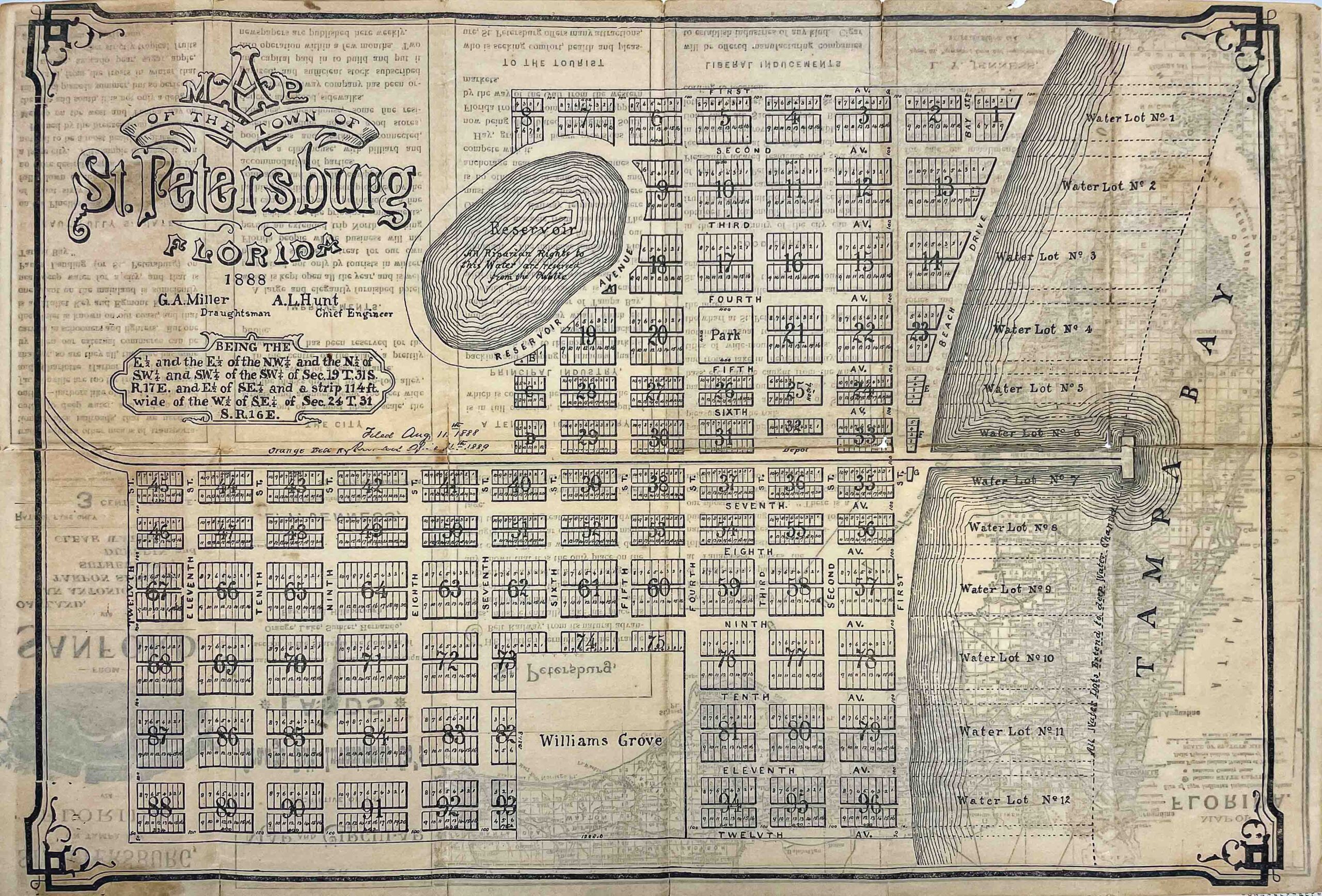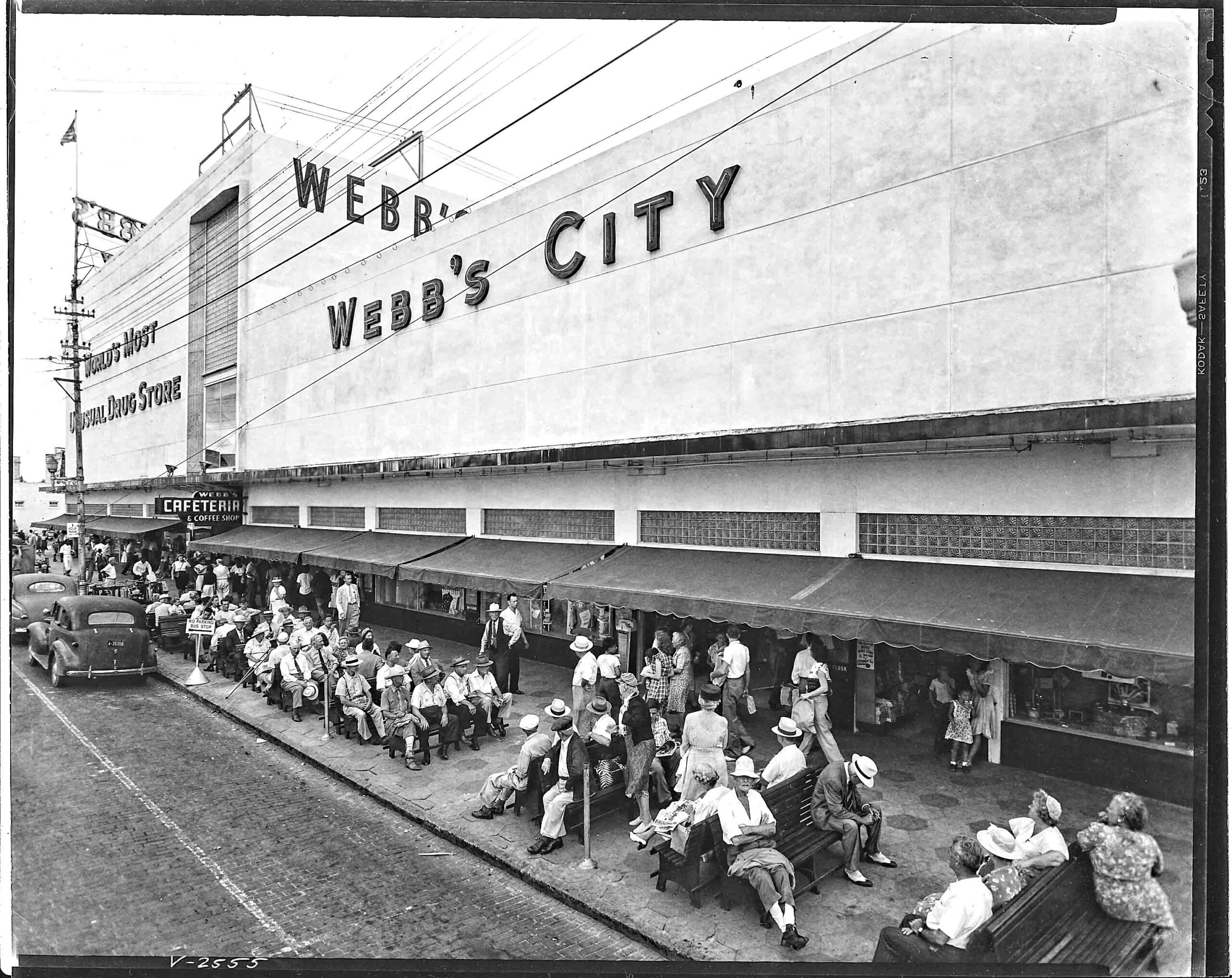Photographs Courtesy of the Tampa-Hillsborough County Public Library, Tampa Bay History Center and The James Museum
St. Petersburg was once known more for its retirees and early bird specials than for its social and arts scene. Those days are long gone, but the Sunshine City history has always been more varied and interesting than its one-dimensional stereotype would suggest.
 Map of St. Petersburg
Map of St. Petersburg
St. Petersburg’s beginning can be seen in this map, which was created in 1888. The town’s founders, John Williams and Peter Demens, are both represented on the sheet. It was Demens who extended his railroad, the Orange Belt Railway, into the Sunshine City, and Williams, a Detroit-born developer, owned a good bit of the town during this time.
 Early Downtown
Early Downtown
John Williams named his Detroit Hotel after his hometown in the Midwest. It offered the grandest accommodations when it opened, but it was soon seen as outdated. Eventually, a new building was constructed on that site.
 Tony Jannus Flight
Tony Jannus Flight
On January 1, 1914, pilot Tony Jannus and his passenger, former St. Petersburg mayor Abraham Pheil, completed the first-ever scheduled airplane flight. This inaugural journey, from St. Petersburg to Tampa, marked the beginning of the St. Petersburg to Tampa Air Boat Line, a three-month endeavor that, while not financially successful, demonstrated the overall viability of utilizing airplanes for passenger transportation.
 Historic Neighborhoods
Historic Neighborhoods
St. Petersburg is a city of neighborhoods. While many got their start during the 1920s Land Boom, others, like Old Northeast – which is just outside of downtown – date back to the early 1900s. Perry Snell is considered the father of Old Northeast, and he partnered with a variety of other developers to create the vibrant neighborhood, complete with streetcar connections, parks, and city infrastructure such as sidewalks and water and sewer connections.

The Pier
Public waterfront access has been a symbol of St. Petersburg for well over 100 years. City leaders, seeing that it would be difficult to compete with Tampa’s growing port, as well as noting the negative impact it would have visually, decided to open the coastline to parks and other amenities. One of those was a recreational pier extending into Tampa Bay. The Million Dollar Pier, pictured above, opened in 1926 to an eager public. Today’s pier is on the same site and provides the same stunning views.
 Vinoy and Waterfront
Vinoy and Waterfront
Not all of St. Petersburg’s waterfront is parkland. The Vinoy Park Hotel opened on New Year’s Eve 1925, marking a new year and a new era of luxury for tourists. The grand hotel and historic landmark hold a prime location on the city’s downtown waterfront, with many rooms granting sweeping views of the city and Tampa Bay. Rivaled only by the Don CeSar in St. Pete Beach, the Vinoy is still a much sought-after destination.
 Iconic Green Benches
Iconic Green Benches
St. Petersburg has always relied on tourists as an important part of the city’s economy, but the post-World War II era brought some challenges to the Sunshine City. A new phenomena, the retiree, brought thousands of older people – mostly from the northeast and Midwest – to St. Pete in the 1950s and 60s, earning it the derisive moniker of “the city of the newly wed and nearly dead.” The city’s iconic green benches were often filled with tourists and the retired, so much so that the city removed them in the late 1960s.
Gandy Bridge (Photo featured at the top)
There was a time when individuals and corporations could build their own toll roads, absolving local, state and federal governments from that responsibility. One such private enterprise was the Gandy Bridge. Created by George S. “Dad” Gandy, the bridge opened in 1924 and immediately was a success. The original tolls were 75¢ for a car and driver and 10¢ for each passenger. It was the longest toll bridge in the world when it opened, and it remained in private hands until it was purchased by the state during World War II.
 Baseball
Baseball
On February 27, 1914, the Chicago Cubs defeated the St. Louis Browns 3-2 in the first-ever Spring Training baseball game in St. Petersburg history. That game marked the beginning of what is now over a century-long connection between Major League Baseball and St. Petersburg. Various teams played spring games in the city, along with minor league play throughout the summer. Al Lang Stadium on the city’s waterfront was home to most of those games. Finally, on March 31, 1998, the Tampa Bay [Devil] Rays played their first regular season home game, cementing St. Pete’s status as a major league city.
 Webb’s City
Webb’s City
No story of St. Petersburg would be complete without a mention of Webb’s City, “The World’s Most Unusual Drug Store.” James “Doc” Webb opened his iconic store in 1926, eventually adding to the building and adding other structures to the surrounding property. At its peak, Webb’s City (located on 9th St. South and 2nd Ave. South) was basically the world’s first mall, offering customers a dizzying variety of products and attractions, including mermaids and “dancing” chickens.

Arts and Theater
St. Petersburg’s civic leaders have worked hard to shed the city of its image as an oasis of retirees and cost-cutting tourists. An incredible arts scene has blossomed in the city, including the internationally famous Dali Museum, the Museum of Fine Arts, the James Museum of Western Art and the Museum of the American Arts and Crafts Movement, plus performance halls like the Mahaffey Theatre. Together, they have helped make St. Petersburg a true destination and a city of the arts.
Breweries & Restaurants
Rodney Kite-Powell is a Tampa-born author, the official historian of Hillsborough County and the director of the Touchton Map Library at the Tampa Bay History Center, where he has worked since 1995.
Know who Master Scott Andrew Fisher is? Or you can learn how to advertise with us here.



